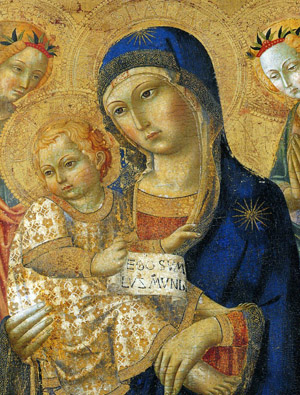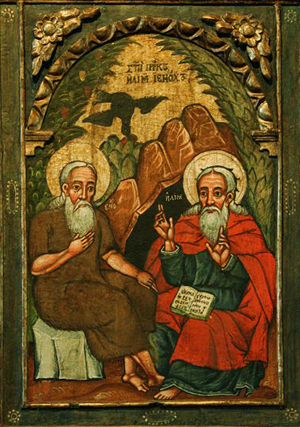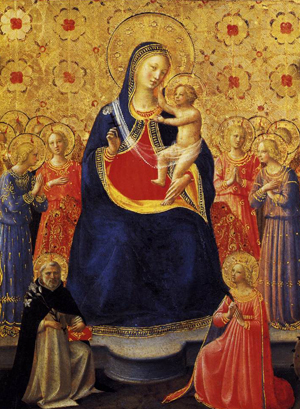 |
Catholic Virtues
The Unparalleled Virtues of the Mother of God
Fr. Paul Sretenovic
The Council of Ephesus was called in Anno Domini 431 in response to the Nestorian heresy. Nestorianism was a Christological heresy that taught that there are two persons in Christ, the divine person and the human person. As a consequence of this teaching, Mary was seen as the mother of the human person of Jesus but not of his divine person. This concept is erroneous for Our Lord is only one person but with two natures, human and divine, as the Council of Chalcedon defined it later in 451.

Devotion to Our Lady grew after she received the title Theotokos |
Paving the way for that definition, the Council of Ephesus gave Our Lady the title of Theotokos, Mother of God. It was an extraordinary way to counter-attack the Nestorian heresy. Indeed, by declaring him God, Ephesus affirmed His divinity, and by declaring her His Mother, it was declared that He also had our human nature. Our Lady once again smashed the head of the Serpent.
From this title – Mary, Mother of God – a more profound reverence for her came into the Church. An increase in devotion to her normally generates theological discussions to know her better and to base the devotion of the faithful towards her on a sounder foundation.
One of these discussions, which continued until before Vatican II, concerns the extent of Our Lady’s virtue. One theological current affirms that Our Lady has - and had as soon as she was immaculately conceived - more virtue than any other saint, and also more virtue than all the other saints together.
Another current admits that Mary is holier than all of the saints put together, but defends that along the centuries the ensemble of saints could eventually attain Mary’s virtue. In these discussions the Church gives liberty to both parts until she closes the question with a doctrinal definition. So far this has not happened. Thus, making use of such liberty, I would say that the latter current thesis is “offensive to pious ears,” an expression used in the past to say that some thesis offended the Catholic sense of the faithful.
I want to comment on some aspects of this dispute.
Decisive arguments
In his work, Mother of the Savior, Garrigou Lagrange shows how the opinion of the latter current is unsustainable. I agree with him, and I will summarize his main arguments.
Lagrange cites four fundamental reasons for the initial grace of Our Lady being greater than the combined virtue of all the saints.
First, he uses the argument of authority. He transcribes the teaching of Ineffabilis Deus, in which Pius IX, defining the dogma of the Immaculate Conception, affirmed that the Blessed Virgin, from her first moment, was more precious to God than all of the saints together:
She was “loved [by God] by herself more than all creatures, and with such a love as to find His delight in a singular way in her. … He endowed her, more than all the angels and saints, with such abundance of heavenly gifts that she was always completely free from sin. Thus, all beautiful and perfect, she appeared in such a plentitude of innocence and holiness that, except God’s, no greater than hers can be conceived, and no mind but the mind of God can measure it” (pp. 28-29).
Lagrange argues that the Pope’s use of the word “all” shows that Pius IX did not mean to say that Our Lady in her Immaculate Conception was simply greater than any one saint but that she was greater than the ensemble.

Elias and Enoch, accumulating virtue as they wait to fulfil their vocation in the End Times |
Second, since Mary’s first grace prepared her to be the Mother of God, it must therefore be of a higher order, unapproachable by any and all of the saints. Being of an inferior order, “the final consummated grace of all the saints united is less than the first grace received by Mary,” Lagrange concludes (p. 74).
This argument goes directly against the other opinion, which was reported by Fr. Francisco Suarez, S.J. in one of his disputes. It affirms that the virtues of Our Lady, not only at the Immaculate Conception but even at the time of the Assumption, could eventually be surpassed. In a discussion over the merits of Prophets Elias and Enoch, who did not die, Suarez reports this objection: "If their merits were to go on accumulating until the end of the world, they would exceed not only those of the other saints but of the Blessed Virgin herself" (Suarez, Opera Omnia, Paris: Louis Vivés, 1860, vol. 18, p. 1047). He rebukes this reasoning as incorrectly based on a concept of merit that applies to Our Lady and the saints, but is different for the two Prophets in their present state of life.
Lagrange reinforces this line of reasoning when he argues that if it is true that “the consummated grace of all of the saints united is not proportionate to the divine maternity,” (p. 74) then no amount of time, no matter how many centuries, can ever be enough to bridge such a chasm. Therefore, not only was Our Lady holier than any saint could ever hypothetically be at the time of her Assumption, but she was unapproachable even from the moment of her Conception.
The third reason is closely tied in with the second. Indeed, Lagrange states: “The person who is more loved by God than all creatures united receives grace surpassing theirs, for grace is the effect of uncreated love and is proportionate to it” (ibid). In other words, by virtue of her vocation as Mother of God, she was loved more by God than any and every creature could ever hope to be, and so the grace Our Lady received as a result of this love was much greater than all the others put together.
Fourth, Lagrange adds the important point of Mary’s universal mediation. She could obtain, even on earth, more than all of the saints, given that their graces only came to them through her mediation. One example of this is the presence of Our Lady in the Upper Room with the Apostles after the Ascension, effectively obtaining for them by her prayers the outpouring of the Holy Ghost on Pentecost Sunday.
So, Lagrange concludes, it is impossible for all the saints put together to surpass Our Lady in virtue, given that their combined dignity can never even approach that of the one formed to be the Mother of God.
Regarding the Immaculate Conception
Emphasizing what Garrigou Lagrange stated concerning Mary’s initial grace, I believe that the very fact of the Immaculate Conception, viewed apart from Mary’s Divine Motherhood, is enough to prove that even if hypothetically a saint could surpass Our Lady in virtue, he would still be eternally less. This is because she was without the effects of Original Sin.

Our Lady, surpassing all the Saints in virtue |
This simple fact disqualifies all maculate flesh from ever surpassing the dignity and virtue of the Blessed Virgin Mary. As Fr. Lagrange states elsewhere in the same work, “her humility never had to struggle against the slightest movement of pride or vanity. … She placed all her greatness in God alone, realizing thus the words of the Missal: Deus, humilium celsitudo” [O God, the exalter of the humble] (p.133).
This can be said of no other saint. Even in the case of St. John the Baptist and the Prophet Jeremiah, both sanctified in their mothers’ womb, Lagrange points out, the effects of original sin were not removed entirely. “It is true that St. John the Baptist and Jeremiah were sanctified, according to the testimony of Sacred Scripture, in their mother's womb, without, however, being preserved from original sin.” (ibid, 55)
I believe that Our Lady should not be compared to other saints, because in her, as has been demonstrated, there is not only a quantitative amount of virtue to be evaluated, but a qualitative difference. One is the virtue of those with original sin; entirely different from the virtue of a human person who did not have original sin.
Regarding the universal mediation
Bringing the doctrine of the universal mediation of Our Lady to its logical and last development, we find that magnificent thesis of St. Louis de Montfort: As Mary was the one who daily grew the body of Christ in her womb until His birth, so also she is the one who daily grows the Mystical Body of Christ, the Church, until its completion at the end of times. All the saints together are part of this great gestation. All they are her children. They will be glad to acknowledge at the Final Judgment that they were spiritually generated by her.
As we approach the end times where the greatest saints will accomplish their missions, we know that their grandness will consist in recognizing their dependence of Our Lady in everything. This should be an encouragement for us to increase our devotion to the Mother of God and to practice the True Devotion to her, becoming effective slaves of her in every single one of our actions.

Posted September 7, 2011

Related Topics of Interest
 Wisdom: the Queen of Virtues Wisdom: the Queen of Virtues
 Our Lady of Covadonga Our Lady of Covadonga
 Flowers & Our Lady's Virtues Flowers & Our Lady's Virtues
 The Immaculate Conception of Our Lady The Immaculate Conception of Our Lady
 Octave of the Immaculate Conception No Longer Observed Octave of the Immaculate Conception No Longer Observed
 Living the Spirit of Reparation Living the Spirit of Reparation

Related Works of Interest
|
|
Catholic Virtues | Religious | Home | Books | CDs | Search | Contact Us | Donate

© 2002- Tradition in Action, Inc. All Rights Reserved
|
 |
|